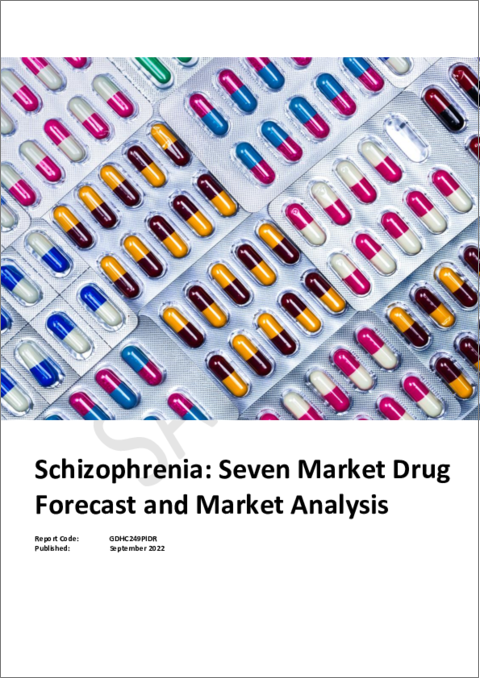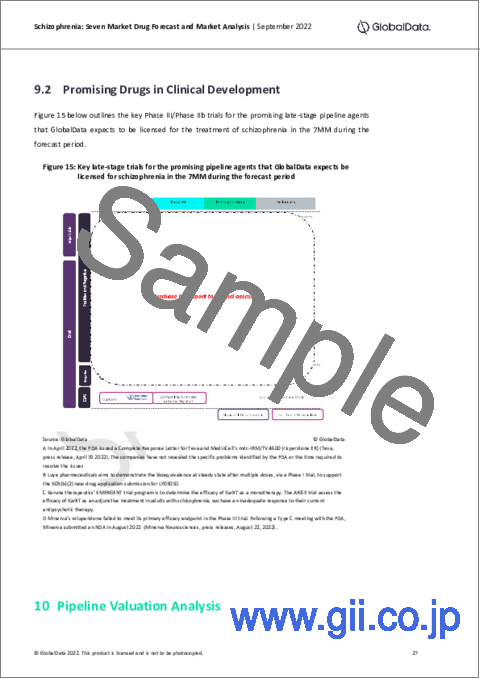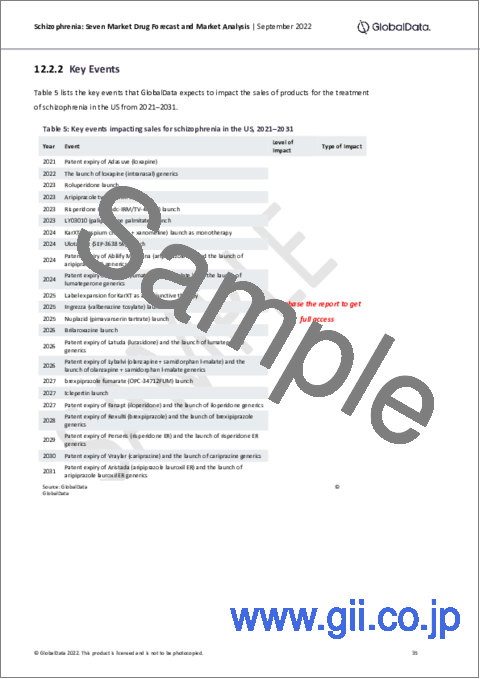|
|
市場調査レポート
商品コード
1143351
統合失調症市場:規模および動向 - 疫学およびパイプライン分析、競合企業評価、アンメットニーズ、臨床試験戦略、予測(2021年~2031年)Schizophrenia Market Size and Trend Report including Epidemiology and Pipeline Analysis, Competitor Assessment, Unmet Needs, Clinical Trial Strategies and Forecast, 2021-2031 |
||||||
|
● お客様のご希望に応じて、既存データの加工や未掲載情報(例:国別セグメント)の追加などの対応が可能です。 詳細はお問い合わせください。 |
|||||||
| 統合失調症市場:規模および動向 - 疫学およびパイプライン分析、競合企業評価、アンメットニーズ、臨床試験戦略、予測(2021年~2031年) |
|
出版日: 2022年09月21日
発行: GlobalData
ページ情報: 英文 129 Pages
納期: 即納可能
|
- 全表示
- 概要
- 図表
- 目次
主要7ヶ国の統合失調症の市場規模は、2021年に90億米ドルとなりました。同市場は今後10年間、3.7%のCAGRで拡大し、2031年には130億米ドルに達すると予測しています。
当レポートでは、主要7ヶ国の統合失調症市場について調査し、疾患の概要と疫学、治療法、SWOT分析、パイプライン製品動向、アンメットニーズと機会、市場の見通しなどを提供しています。
目次
目次
第1章 統合失調症:エグゼクティブサマリー
第2章 イントロダクション
第3章 疾患の概要
- 病因と病態生理学
- 分類または病期分類システム
第4章 疫学
- 疾患の背景
- 危険因子と合併症
- 世界的および歴史的な動向
- 主要7ヶ国の予測調査手法
- 統合失調症の疫学的予測(2021年~2031年)
- 討論
第5章 疾病管理
第6章 競争力の評価
- 概要
第7章 アンメットニーズと機会の評価
- 概要
- 統合失調症に伴う認知障害に対する治療法の開発
- 陰性症状に対する治療法の開発
- 治療抵抗性患者に対する治療法の開発
- 患者の洞察力と治療への遵守の改善
第8章 研究開発戦略
- 概要
- 臨床試験デザイン
第9章 パイプラインの評価
第10章 パイプライン評価分析
- 概要
- 競争力評価
第11章 現在および将来の参入企業
- 概要
- 取引動向
第12章 市場の見通し
第13章 付録
List of Tables
List of Tables
- Table 1: Schizophrenia: Key metrics in the 7MM
- Table 2: Risk factors and comorbid conditions associated with schizophrenia
- Table 3: Treatment Guidelines for Schizophrenia
- Table 4: Schizophrenia market - global drivers and barriers, 2021-2031
- Table 5: Key events impacting sales for schizophrenia in the US, 2021-2031
- Table 6: Schizophrenia Market - Drivers and Barriers in the US, 2021-2031
- Table 7: Key events impacting sales for schizophrenia in the 5EU, 2021-2031
- Table 8: Schizophrenia market - drivers and barriers in the 5EU, 2021-2031
- Table 9: Key Events Impacting Sales for Schizophrenia in Japan, 2021-2031
- Table 10: Schizophrenia Market - Drivers and Barriers in Japan, 2021-2031
- Table 11: High-Prescribing Physicians (non-KOLs) Surveyed, By Country
List of Figures
List of Figures
- Figure 1: Global sales forecast by country for schizophrenia in 2021 and 2031
- Figure 2: Analysis of the company portfolio gap in schizophrenia during the forecast period
- Figure 3: Competitive assessment of novel oral atypical antipsychotic pipeline agents that GlobalData expects to be licensed for the treatment of schizophrenia during the forecast period
- Figure 4: Competitive assessment of pipeline atypical antipsychotic reformulations benchmarked against the SOC, Invega Sustenna
- Figure 5: 7MM, 12-month total prevalence (%) of schizophrenia, both sexes, ages ≥13 years, 2021
- Figure 6: 7MM, 12-month diagnosed prevalence (%) of schizophrenia, men and women, ages ≥13 years, 2021
- Figure 7: 7MM, sources used to forecast the 12-month total prevalent cases of schizophrenia
- Figure 8: 7MM, sources used and not used to forecast the 12-month diagnosed prevalent cases of schizophrenia
- Figure 9: 7MM, 12-month total prevalent cases of schizophrenia, N, both sexes, ages ≥13 years, 2021
- Figure 10: 7MM, 12-month diagnosed prevalent cases of schizophrenia, N, both sexes, ages ≥13 years, 2021
- Figure 11: 7MM, 12-month diagnosed prevalent cases of schizophrenia by age, N, both sexes, 2021
- Figure 12: 7MM, 12-month diagnosed prevalent cases of schizophrenia by sex, N, ages ≥13 years, 2021
- Figure 13: Unmet needs and opportunities in schizophrenia
- Figure 14: Overview of the development pipeline in schizophrenia
- Figure 15: Key late-stage trials for the promising pipeline agents that GlobalData expects be licensed for schizophrenia in the 7MM during the forecast period
- Figure 16: Competitive assessment of novel oral atypical antipsychotic pipeline drugs benchmarked against the SOC, Abilify
- Figure 17: Competitive assessment of pipeline atypical antipsychotic reformulations benchmarked against the SOC, Invega Sustenna
- Figure 18: Analysis of the company portfolio gap in schizophrenia during the forecast period
- Figure 19: Global (7MM) sales forecast by country for schizophrenia in 2021 and 2031
- Figure 20: Sales forecast by class for schizophrenia in the 7MM in 2021 and 2031
- Figure 21: Sales forecast by class for schizophrenia in the US in 2021 and 2031
- Figure 22: Sales forecast by class for schizophrenia in the 5EU in 2021 and 2031
- Figure 23: Sales forecast by class for schizophrenia in Japan in 2021 and 2031
Schizophrenia is a heterogeneous behavioral and cognitive syndrome involving chronic or recurrent psychosis. The disorder is characterized by several symptom domains including positive symptoms (such as hallucinations or delusions and disorganized speech), negative symptoms (such as a flat affect and poverty of speech), and cognitive deficits (including impaired attention, memory, and executive functions). As a result, schizophrenic patients commonly experience impairments in social and occupational functioning. The management of schizophrenia is challenging due to its clinical and genetic heterogeneity, which also complicates the elucidation of etiological and pathophysiological factors.
The schizophrenia market in the 7MM was valued at $9.0B in the 2021 baseline year. GlobalData anticipates that over the 10-year forecast period, the market is projected to grow at a Compound Annual Growth Rate (CAGR) of 3.7%, reaching $13.0B by 2031.
The major driver for this growth will be the launch of 11 new pipeline products, each of which will have a higher annual cost of therapy (ACOT) when compared with the cost of the most commonly used antipsychotic treatments, which are highly genericized.
Key Highlights
- There is an increase in the diagnosed prevalent cases of schizophrenia by 2.6% in the 7MM combined over the forecast period.
- The current schizophrenia treatment landscape includes many established atypical antipsychotic products that can help manage the positive symptoms of the disorder, such as hallucinations, delusions, and disorganized speech.
- The schizophrenia market will exhibit moderate growth between 2021 and 2031, driven by the entry of 11 pipeline agents.
- The potential for novel pharmacological therapies specifically indicated for cognitive impairment associated with schizophrenia (CIAS) and the negative symptoms of schizophrenia, two major unmet needs in the market, could provide new options for patients.
- The prospect of four novel adjunctive therapies will be welcomed for patients who have a partial response to marketed antipsychotics. Rather than compete with existing therapies, adjunctive therapies will be prescribed in combination with generic antipsychotics.
Key Questions Answered
- What are the key schizophrenia treatments available in 2021?
- When will the late stage pipeline products launch, and how will they affect drug sales and the overall schizophrenia market in the 7MM?
- Which unmet needs will remain unaddressed in the forecast period and what opportunities remain for pharmaceutical companies?
Scope
- Overview of schizophrenia, including epidemiology, symptoms, diagnosis, and disease management.
- Annualized schizophrenia therapeutics market revenue, cost of therapy per patient, and treatment usage patterns forecast from 2021 to 2031.
- Key topics covered include strategic competitor assessment, market characterization, unmet needs, clinical trial mapping, and implications of these factors for the schizophrenia therapeutics market.
- Pipeline analysis: comprehensive data assessing emerging trends and mechanisms of action under development for schizophrenia treatment. The most promising candidates in Phase III and Phase IIb development are profiled.
- Analysis of the current and future market competition in the global schizophrenia therapeutics market. Insightful review of the key industry drivers, restraints and challenges. Each trend is independently researched to provide qualitative analysis of its implications.
Reasons to Buy
The report will enable you to -
- Develop and design your in-licensing and out-licensing strategies through a review of pipeline products and technologies, and by identifying the companies with the most robust pipeline.
- Develop business strategies by understanding the trends shaping and driving the global schizophrenia therapeutics market.
- Drive revenues by understanding the key trends, innovative products and technologies, market segments, and companies likely to impact the global schizophrenia therapeutics market in the future.
- Formulate effective sales and marketing strategies by understanding the competitive landscape and by analyzing the performance of various competitors.
- Identify emerging players with potentially strong product portfolios and create effective counter-strategies to gain a competitive advantage.
- Organize your sales and marketing efforts by identifying the market categories and segments that present maximum opportunities for consolidations, investments and strategic partnerships.
Table of Contents
Table of Contents
1 Schizophrenia: Executive Summary
- 1.1 The schizophrenia market will grow to $13.0 billion
- 1.2 Key players will struggle to maintain their competitive position
- 1.3 While outlook in schizophrenia improves, opportunities remain to improve patient outcomes
- 1.4 The entry of adjunctive therapies will shape the schizophrenia market
- 1.5 What do physicians think?
2 Introduction
- 2.1 Catalyst
- 2.2 Related Reports
- 2.3 Upcoming Reports
3 Disease Overview
- 3.1 Etiology and Pathophysiology
- 3.1.1 Etiology
- 3.1.2 Pathophysiology
- 3.2 Classification or Staging Systems
4 Epidemiology
- 4.1 Disease background
- 4.2 Risk factors and comorbidities
- 4.3 Global and historical trends
- 4.4 7MM forecast methodology
- 4.4.1 Sources used
- 4.4.2 Forecast assumptions and methods
- 4.4.3 Forecast assumptions and methods: 12-month total prevalent cases of schizophrenia
- 4.5 Epidemiological Forecast for Schizophrenia (2021-31)
- 4.5.1 12-Month total prevalent cases of schizophrenia
- 4.5.2 12-Month diagnosed prevalent cases of schizophrenia
- 4.5.3 Age-specific 12-month diagnosed prevalent cases of schizophrenia
- 4.5.4 Sex-specific 12-month diagnosed prevalent cases of schizophrenia
- 4.6 Discussion
- 4.6.1 Epidemiological forecast insight
- 4.6.2 COVID-19 Impact
- 4.6.3 Limitations of Analysis
- 4.6.4 Strengths of Analysis
5 Disease Management
- 5.1 Diagnosis overview
- 5.2 Treatment overview
- 5.3 Other KOL insights on disease management
6 Competitive Assessment
- 6.1 Overview
7 Unmet Needs and Opportunity Assessment
- 7.1 Overview
- 7.2 Development of therapies to target cognitive impairment associated with schizophrenia
- 7.3 Development of therapies to target negative symptoms
- 7.4 Development of therapies for treatment-resistant patients
- 7.5 Improved patient insight and adherence to treatment
8 R&D Strategies
- 8.1 Overview
- 8.1.1 Reformulations and innovative drug delivery systems
- 8.1.2 Novel MOAs
- 8.1.3 Development of adjunctive therapies
- 8.1.4 Digital therapeutics
- 8.2 Clinical trial design
- 8.2.1 Clinical endpoints
- 8.2.2 Patient Recruitment
9 Pipeline Assessment
- 9.1 Overview
- 9.2 Promising Drugs in Clinical Development
10 Pipeline Valuation Analysis
- 10.1 Overview
- 10.2 Competitive Assessment
11 Current and Future Players
- 11.1 Overview
- 11.2 Deal-making trends




